Forum Replies Created
-
AuthorPosts
-
 John CoffinParticipant
John CoffinParticipantThank you Andy, that’s very helpful. John.
 John CoffinParticipant
John CoffinParticipantAnother idea would be to put an agreed key word or phrase in posts about spectroscopy campaigns so that they were searchable, and also a way of ordering search results by date. An alternative, though maybe messy idea, would be to have a forum just for campaigns. Thanks everyone for all the ideas, maybe it’s something to discuss at the forthcoming spectroscopy workshops.
 John CoffinParticipant
John CoffinParticipantDoes scintillation shift the wavelength of spectra? What would be a reasonable minimum exposure time to avoid problems due to scintillation?
 John CoffinParticipant
John CoffinParticipantThat’s helpful, thanks, John
 John CoffinParticipant
John CoffinParticipantNice spectra. I tried to collect a spectrum of 38P/Stephan-Oterma last week. The spectrum of the nucleus was basically a straight line and the coma indistinguishable from the sky background spectrum from a part of the sky a few degrees away, (total exposure 4200 secs). On reflection I think I was a bit optimistic, the nucleus is mag 14.5 and the total mag is 10. I wondered if a a short focal length telescope is better for spectra of faint comets. What magnitude does a comet need to reach before it’s reasonable to expect to capture a spectrum with amateur equipment?
 John CoffinParticipant
John CoffinParticipantDear Jack, there is a guide to processing hot pixels (bad pixels in PHD2) here https://openphdguiding.org/man-dev/Darks_BadPixel_Maps.htm
I hope that is what you are looking for.
Best wishes, John
 John CoffinParticipant
John CoffinParticipantHere is one from the 18th November with an Alpy.
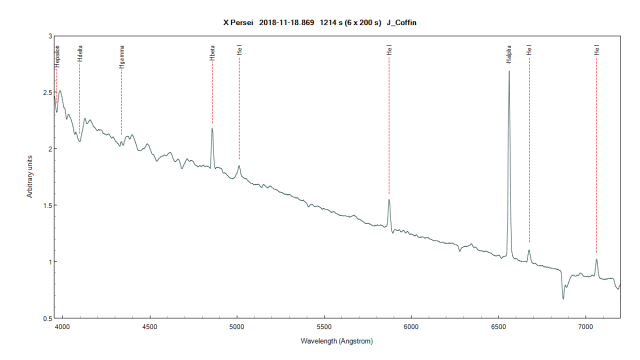
What changes are we looking for, and how often should we monitor with low resolution spectra?
 John CoffinParticipant
John CoffinParticipantI’ve used PHD2. I don’t guide on the target star but on a different one. I then adjust the lock position to move the target star onto the slit. Seems to work well.
There is a step by step guide on how to do this here. https://github.com/OpenPHDGuiding/phd2/wiki/PHD2-Guiding-for-Spectroscopy
 John CoffinParticipant
John CoffinParticipantI took your advice and compared the lamp images from the evening where I had calibration problems. There was a shift of minus 3 A between the first and second lamp image. The meridian flip was between the first and second images. Thereafter the lamp image shifted plus 0.4 A and stayed there.
I thought I had checked everything was tightened, but today I’ve discovered the two Allen head bolts holding the slit in place had worked loose. No idea how!
I don’t think this explains everything though. The star spectra have a different amount of shift at different wavelengths, while the lamp spectra have the same shift all the way along. I can only think that the different light paths of the lamp and the stars are at the root of the problem as you have been saying.
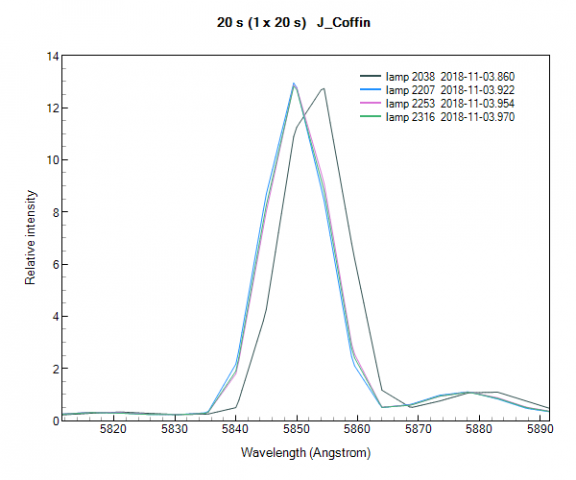
 John CoffinParticipant
John CoffinParticipantThe best fit for Z And was when the only frame taken after the meridian flip was used, and it was calibrated using the mixed Balmer and lamp method. The Balmer lines were found from Pi And (also taken after the flip).
The lamp was the one taken for Z And, after the flip. No heliocentric or corrections for radial velocity were made.
The errors were
H alpha -0.4
H beta +0.65
H gamma +1.2
H delta +1.0
H epsilon -1.0
When the same frame was calibrated using its lamp lines only and not the Balmer lines from Pi And
Errors are:
H alpha -0.4
H beta -1.45
H gamma -1.8
H delta -2.5
H epsilon -3.5
So for me it seems the mixed method gave the best results
 John CoffinParticipant
John CoffinParticipantI’ll do as you say. Thanks.
John
 John CoffinParticipant
John CoffinParticipantDear fellow Alpy users, please see my post #41
Everything In my Alpy is screwed down tight as far as I can tell. Yet I am getting these large disparities in the calibration of H alpha.
It suggests something does change when the instrument moves from one star to another, i thought of checking the Relco bulb isn’t loose, presumably the grism is unlikely to move as it’s held in place by a spring.
The best calibration using the lamp lines occurred when there was a meridian flip between the target and the acquisition of the lamp lines.
 John CoffinParticipant
John CoffinParticipantMethod
Spectra of Zeta Cas and Z And were collected, the latter was exposed for 240s to avoid saturating the H alpha emission line and then a further set of exposures for 600s were taken in order to show more detail in the continuum and other emission lines. Towards the end of the series taken for 600s the telescope reached the meridian and the lamp image for that set was not taken until after the meridian flip. On the other occasions the lamp image was taken immediately after the end of a capture sequence.
Results
The spectra were processed in ISIS in three different ways.
Balmer lines only
This couldn’t calibrate Zeta Cas so was not suitable for Z And either
Mixed Balmer and lamp lines calibration
Each time the lamp lines for the particular target were used.
Zeta Cas H alpha blue shift 1 A, accurate from H beta onwards towards the UV end.
Z And (600s) H alpha red shift 2 A, gradually increasing so at H delta the red shift was 3.4 A.
Z And (240s) H alpha blue shift 6 A, reducing so at H delta the blue shift was 4.0 A.
In all targets using the mixed method the wavelength errors become more shifted towards the red at shorter wavelengths.
Lamp lines only calibration
Zeta Cas H alpha blue shift 1 A, increasing so at H delta the blue shift was 4.5 A.
Z And (600s) H alpha red shift 0.7, accurate calibration from H beta to H delta. H epsilon was blue shifted by 1.5 A.
Z And (240s) H alpha blue shift 6.0 A, increasing so that at H delta the blue shift was 7.7 A.
So in all the targets calibrated by the lamp lines alone, the wavelength error shifts towards the blue at shorter wavelengths.
I will be very interested to see the result of your Filly Dot experiment. I may have to throw away my calibration module. (I’ll keep it for the flat fields actually).
Cheers, John
 John CoffinParticipant
John CoffinParticipantThanks for all your advice. Much appreciated!
John
 John CoffinParticipant
John CoffinParticipantNo, I didn’t tick that box. Here is the new improved lamp spectrum which looks accurate. I noticed that the intensity of the lines that ISIS uses for calibration are much weaker than those above 7000 A. Perhaps I should not worry about saturating those brighter lines and try using a longer exposure in order to make the ones used by ISIS brighter.
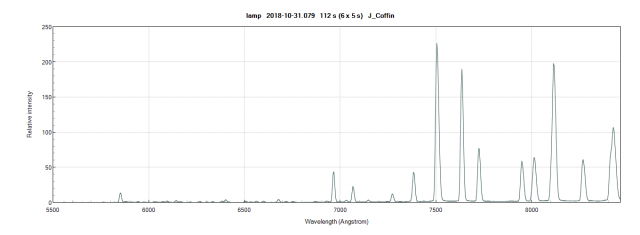
What do you think is the way forward now? I was hoping to submit spectra to our database. Should I put a comment in the FITs header about the calibration method and its (?) inherent problems, ie mixed method with accuracy upto H beta, 3A blueshift near H alpha.
What would be the best way to calibrate now? Would it depend on the nature of the target?
 John CoffinParticipant
John CoffinParticipantHi Andrew, I’ve processed the calibration image as is if were a star, of course I had to use the same image to calibrate it. The result was odd, but the neon 6965 line was incorrectly calibrated.

The lines are broad and fuzzy in this area, so perhaps I need to focus it better there?
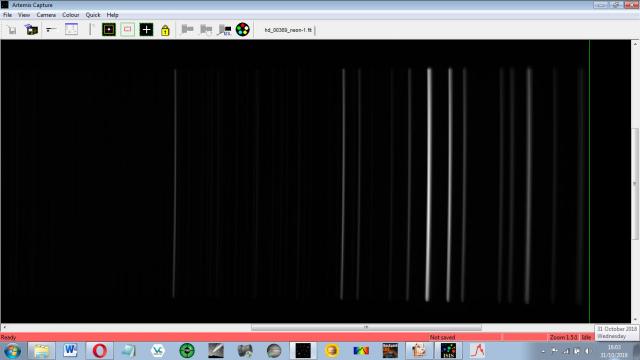
I understand that if I do this I will lose definition at the blue end of the spectrum. Thank you for your thoughts on this issue. I am very grateful for everyone’s input into this.
I’ve attached the files of these images.
Regards, John
 John CoffinParticipant
John CoffinParticipantLast night’s specrum of Pi Andromeda (HD 00369) was still about 3 A out at H alpha but very accurate from H beta to epsilon.
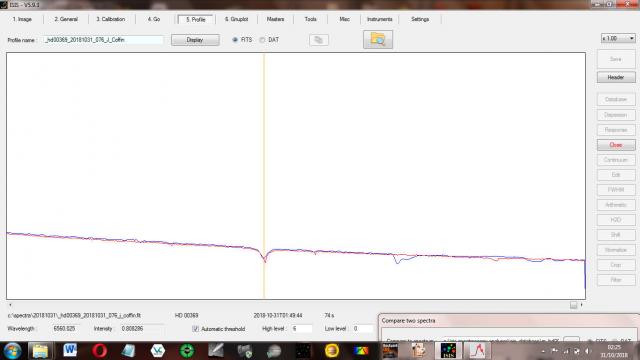
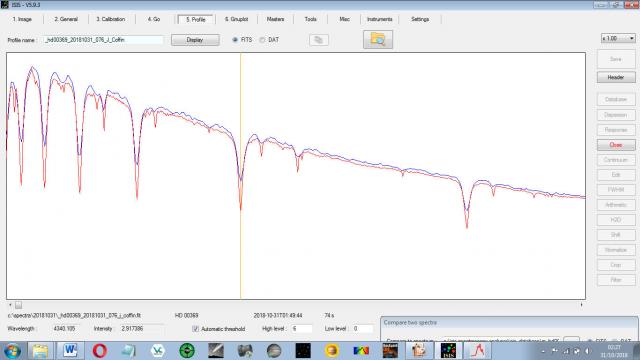
If this is an error due to undersampling why would it only affect H alpha?
If undersampling is the issue, can I calibrate the dispersion of a spectrum collected binned x 2 using a reference star that was not binned?
 John CoffinParticipant
John CoffinParticipantThe reflector isn’t perfectly straight and the bulb emits light from one side of itself.
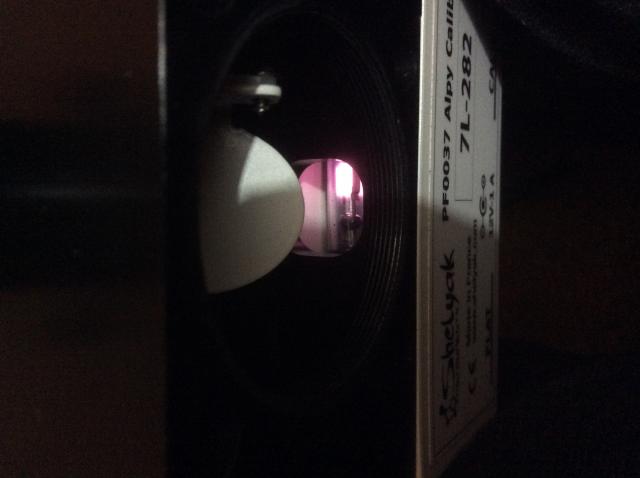
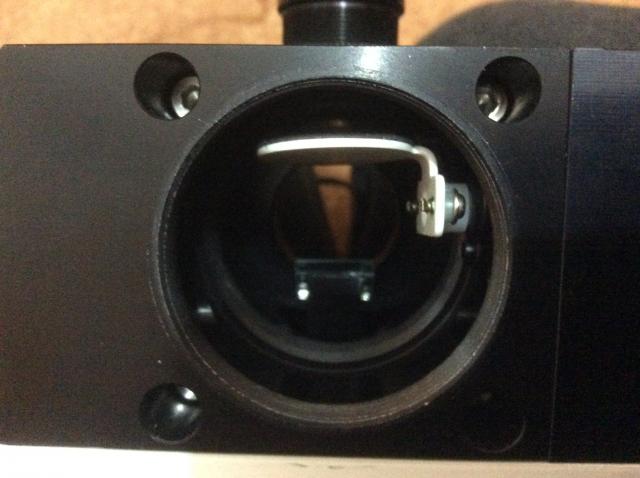
 John CoffinParticipant
John CoffinParticipantI took these lamp lines indoors. The one I took last night was saturated towards the red end of the spectrum and gave me a similar result and were taken at the end of the evening after the calibration star. The ambient temperature was 2 C last night. Next time I will take some in the middle of the target exposures, and again with the reference star and see if that makes any difference.
 John CoffinParticipant
John CoffinParticipantDear Robin, all the Balmer lines were blue shifted by about 2 A, though H zeta and H epsilon were shifted by 3 and 2.5 A respectively.
I’ll check all the connectors, though I thought they were tight really.
Here’s the report
Load the image : c:spectra20181028zeta_draconis-1.fit
Load the image : c:spectra20181028zeta_draconis-2.fit
Load the image : c:spectra20181028zeta_draconis-3.fit
Load the image : c:spectra20181028zeta_draconis-4.fit
Load the image : c:spectra20181028zeta_draconis-5.fit
Load the image : c:spectra20181028zeta_draconis-6.fit
Substract the offset : c:spectra20181028caliboffset.fit
Substract the dark : c:spectra20181028calibdark600_b2_minus10-.fit
Dark coefficient (1) : 0.0333
Dark coefficient (2) : 0.0333
Dark coefficient (3) : 0.0333
Dark coefficient (4) : 0.0333
Dark coefficient (5) : 0.0333
Dark coefficient (6) : 0.0333
Divide by the flat-field : c:spectra20181028flat.fit
Flat-field level : 38096
Cosmetic correction : c:spectra20181028calibcosme.lst
Smile correction – Y0 = 658 Radius = 11056
Transverse registration at intermediate Y coordinate = 533.00
Spectrum Y coordinate Y 1 = 533.31
Spectrum Y coordinate Y 2 = 533.47
Spectrum Y coordinate Y 3 = 533.53
Spectrum Y coordinate Y 4 = 533.73
Spectrum Y coordinate Y 5 = 533.76
Spectrum Y coordinate Y 6 = 533.58
Remove sky background
Save image : c:spectra20181028@s.fit (sky not removed)
Save 0b product : c:spectra20181028_Zeta Dra.fit (2D image)
Adopted Y coordinate : 532.51
Tilt correction (second pass)
Remove sky background (second pass)
Write 2D image : c:spectra20181028@1.fit
Write 2D image : c:spectra20181028@2.fit
Write 2D image : c:spectra20181028@3.fit
Write 2D image : c:spectra20181028@4.fit
Write 2D image : c:spectra20181028@5.fit
Write 2D image : c:spectra20181028@6.fit
Optimal binning
Write raw profile : c:spectra20181028@raw1.dat
Write raw profile : c:spectra20181028@raw2.dat
Write raw profile : c:spectra20181028@raw3.dat
Write raw profile : c:spectra20181028@raw4.dat
Write raw profile : c:spectra20181028@raw5.dat
Write raw profile : c:spectra20181028@raw6.dat
Intensity of individual profiles (ADU)…
Mean (median) for profile #1 : 278613 (48845)
Mean (median) for profile #2 : 267945 (46851)
Mean (median) for profile #3 : 274931 (46238)
Mean (median) for profile #4 : 283742 (47380)
Mean (median) for profile #5 : 261979 (48189)
Mean (median) for profile #6 : 248222 (44512)
Standard summation of individual profiles
Save uncalibrated spectral profile : c:spectra20181028@star.dat
Processing of calibration image : c:spectra20181028neon5.fit
Dark coefficient (calibration) : 0.0083
Save image : c:spectra20181028@calib.fit (2D image)
Save spectral profile : c:spectra20181028@calib.dat
Spectral calibration
————————————————————————–
Primary dispersion :
Coefficient a4 : -1.941613E-13
Coefficient a3 : 5.199794E-09
Coefficient a2 : -4.783460E-05
Coefficient a1 : 0.39175
Coefficient a0 : -710.014
————————————————————————–
RMS : 0.091500 (en pixels)
————————————————————————–
Primary wavelength fit deviation
point #1 Lambda = 3770.630 px = 326.562 dx = -0.067
point #2 Lambda = 3797.300 px = 332.190 dx = 0.154
point #3 Lambda = 3835.390 px = 340.215 dx = -0.078
point #4 Lambda = 3889.050 px = 351.495 dx = -0.013
point #5 Lambda = 3970.080 px = 368.476 dx = 0.043
point #6 Lambda = 4101.750 px = 395.954 dx = -0.049
point #7 Lambda = 4340.480 px = 445.487 dx = -0.017
point #8 Lambda = 4861.340 px = 552.926 dx = 0.039
point #9 Lambda = 6562.850 px = 910.356 dx = -0.070
point #10 Lambda = 6869.000 px = 976.968 dx = 0.067
point #11 Lambda = 7605.000 px = 1140.339 dx = -0.009
————————————————————————–
Inverse dispersion equation
Coefficient a4 : 2.999117E-10
Coefficient a3 : -1.336891E-06
Coefficient a2 : 1.632851E-03
Coefficient a1 : 4.09469
Coefficient a0 : 2135.790
————————————————————————–
RMS : 0.311249 (in angstroms)
————————————————————————–
Wavelength fit deviation
point #1 x = 397.713 lambda = 3945.982 dlambda = 0.118
point #2 x = 441.652 lambda = 4158.959 dlambda = -0.369
point #3 x = 513.877 lambda = 4510.640 dlambda = 0.090
point #4 x = 520.824 lambda = 4544.520 dlambda = 0.530
point #5 x = 544.099 lambda = 4658.045 dlambda = -0.145
point #6 x = 565.974 lambda = 4764.726 dlambda = 0.144
point #7 x = 607.204 lambda = 4965.603 dlambda = -0.523
point #8 x = 696.858 lambda = 5400.458 dlambda = 0.102
point #9 x = 791.067 lambda = 5852.415 dlambda = 0.075
point #10 x = 878.731 lambda = 6266.457 dlambda = 0.033
point #11 x = 930.316 lambda = 6506.578 dlambda = -0.048
point #12 x = 1071.150 lambda = 7147.069 dlambda = -0.029
point #13 x = 1124.583 lambda = 7383.958 dlambda = 0.022
————————————————————————–
Coefficient a4 : 2.999117E-10
Coefficient a3 : -1.336891E-06
Coefficient a2 : 1.632851E-03
Coefficient a1 : 4.09469
Coefficient a0 : 2135.790
————————————————————————–
RMS : 0.311249
————————————————————————–
—————————————————————————-
Normalization spectral range : [6650 – 6750]
Normalization value (final profile) : 42355639.7
Normalization value (individulal profile #1) : 7359979.4
Normalization value (individulal profile #2) : 7024372.2
Normalization value (individulal profile #3) : 7031455.9
Normalization value (individulal profile #4) : 7078341.5
Normalization value (individulal profile #5) : 7177964.8
Normalization value (individulal profile #6) : 6683525.9
—————————————————————————-
Spectrum #1 ( b ) – ( v ) intensity = ( 0.836 ) – ( 0.996 )
Spectrum #2 ( b ) – ( v ) intensity = ( 0.860 ) – ( 0.994 )
Spectrum #3 ( b ) – ( v ) intensity = ( 0.910 ) – ( 0.997 )
Spectrum #4 ( b ) – ( v ) intensity = ( 0.948 ) – ( 0.998 )
Spectrum #5 ( b ) – ( v ) intensity = ( 0.784 ) – ( 0.996 )
Spectrum #6 ( b ) – ( v ) intensity = ( 0.796 ) – ( 0.997 )
( b ) – ( v ) mean intensity = ( 0.856 ) – ( 0.996 )
( b ) – ( v ) median intensity = ( 0.860 ) – ( 0.997 )
—————————————————————————-
Write individual DAT processed profile : c:spectra20181028@pro1.dat
Write individual DAT processed profile : c:spectra20181028@pro2.dat
Write individual DAT processed profile : c:spectra20181028@pro3.dat
Write individual DAT processed profile : c:spectra20181028@pro4.dat
Write individual DAT processed profile : c:spectra20181028@pro5.dat
Write individual DAT processed profile : c:spectra20181028@pro6.dat
Write individual FITS processed profile : c:spectra20181028@pro1.fit
Write individual FITS processed profile : c:spectra20181028@pro2.fit
Write individual FITS processed profile : c:spectra20181028@pro3.fit
Write individual FITS processed profile : c:spectra20181028@pro4.fit
Write individual FITS processed profile : c:spectra20181028@pro5.fit
Write individual FITS processed profile : c:spectra20181028@pro6.fit
—————————————————————————-
Write final profile : c:spectra20181028_zetadra_20181028_970_J_Coffin.fit
Write final profile : c:spectra20181028_zetadra_20181028_970_J_Coffin.dat
Intermediate files removed
—————————————————————————-
Acquisition starting date : 28/10/2018 23:16:27
Duration : 42.0 secondes
Mid-exposure date : 28.970/10/2018
Mid-exposure Julian day : 2458420.4700
Resolution power : 507.6
Ok.
-
AuthorPosts
